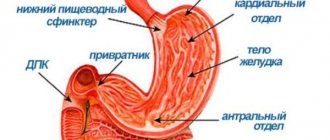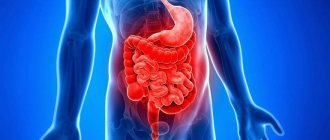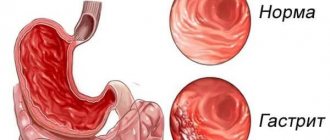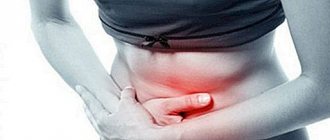Have you been struggling with GASTRITIS and ULCERS for many years without success?
“You will be amazed at how easy it is to cure gastritis and ulcers just by taking it every day...
Read more "
An additional symptom of many diseases of the digestive system is swelling and redness of the mucous membrane. The fact that the gastric mucosa is hyperemic is clearly visualized during the patient's gastroduodenoscopy. Such an examination is prescribed by a doctor if an ulcer, gastritis, pancreatitis is suspected, which are accompanied by other symptoms (pain in the epigastric region, nausea, belching, flatulence).
What is the problem
If the results of gastroscopy indicate that the gastric mucosa is focally hyperemic, this indicates the development of the initial stage of the inflammatory process in the gastric walls. This is not a separate disease, but an additional symptom of the main pathological processes developing in the epigastric region.
It is very important to consult a doctor in time, do not ignore pain in the upper stomach, nausea, and heartburn. Focal hyperemia of the gastric mucosa accompanies most diseases localized in this area, but it is detected only during diagnosis.
Normally, the gastric mucosa is pink, smooth, and reflects the shine of endoscopic equipment. The thickness of the folds should not be less than 5 mm, more than 8 mm. When expanded with air, the folds should be completely straightened.
With the development of any pathological processes, the clinical picture changes - the following signs appear:
- thickening or thinning;
- redness;
- swelling;
- ulcerations.
In the presence of an inflammatory process, the gastric mucosa is visualized as focally or diffusely hyperemic. Externally, its surface is reddened, swelling is observed, and the vessels are filled with blood fluid.
The reasons that caused excessive congestion of blood vessels may be:
- dysfunction in the outflow of blood from the gastric walls;
- excessive filling of the walls with blood.
At the same time, active hyperemia is a positive process, since its result is recovery, but with a lack of blood supply, the regenerative function is inhibited, and damage to the walls is aggravated. All these negative processes occur against the background of oxygen starvation of tissues. Only a specialist can determine, based on the results of examinations, how serious the lesion is and prescribe a competent treatment regimen.
Possible complications, prognosis
Most complications are related to the underlying cause. If measures are not taken to eliminate it, the following consequences may occur:
- adenomatous polyps - multiple benign neoplasms in the stomach;
- stomach bleeding;
- malignant neoplasm;
- anemia as a result of poor iron absorption;
- chronic pancreatitis – inflammation of the pancreas;
- cholecystitis - inflammation of the gallbladder.
Hyperemia itself is not dangerous. The prognosis depends on the severity of the underlying disease. In most cases it is favorable. If we take into account the most likely diagnoses (diseases of the gastrointestinal tract).
Diagnostic measures
If any suspicious symptoms appear (for example, nausea, bloating, heartburn, belching, pain), it is very important to visit a gastroenterologist in a timely manner. One of the main methods for studying the condition of the mucosa is a procedure called esophagogastroduodenoscopy. It is performed using an endoscope - a special probe with a camera at one end to view the internal state.
Using this method, you can accurately assess the condition of the body and the internal walls of the stomach, take a piece of tissue for analysis (biopsy), visualize the presence of a pathological process, and prescribe the correct course of therapy.
A competent specialist will easily determine the presence of pathology in hyperemic epithelium, since healthy tissue looks shiny and produces mucus normally. During the examination, when inflated with air, the folds are straightened, the surface is smooth, the epithelial cover is intact and clean, without wounds or ulcerations. The color is pink, there may be a yellowish coating.
As the disease develops, the symptoms worsen, redness of the epithelial layer appears, the folds increase, do not straighten when inflated, and swelling is observed.
Treatment of the stomach with hyperemic mucosa
Hyperemic gastric lining occurs in several varieties.
The type of hyperemia determines the diagnosis of the disease. With superficial gastritis, hyperemia reaches a moderate degree. The inflammatory process can cover a separate area or become widespread. During the acute course of the disease, the endoscope reveals white foam, the folds of the organ look thicker than normal. When gas is injected, it is not possible to completely achieve a smooth inner wall.
https://www.youtube.com/watch?v=v1hPoxi3s54
Atrophic gastritis is characterized by focal thinning of the membrane. The vascular pattern in this place is clearly visible, the areas of the mucosa around the atrophic zone look paler.
If the hyperemic gastric mucosa is accompanied by the release of purulent masses, such gastritis has a fibrous form. The disease rarely has independent factors of genesis; in most cases, scarlet fever or measles have consequences in the form of hyperemia of the mucous membrane, followed by vomiting with blood. This is how areas of dead mucous membrane with pus are rejected and is accompanied by intense pain.
Phlegmous gastritis is usually called hyperemia of an area of the mucous membrane that has been subjected to injury or sexually transmitted infection.
The gastric mucosa is hyperemic with necrotic gastritis.
Alkali or acid in the stomach causes deep damage to many layers of the digestive organ. Necrotic areas are not the worst option for the development of necrotic gastritis. It is worse if provoking factors cause perforation of the walls of the organ, pouring its contents into the abdominal space and causing peritonitis.
An accurately identified form of gastritis is the key to successful treatment, which is comprehensive. Neglect of the pathology and failure to comply with doctor’s instructions complicates the treatment of gastritis. For this reason, the outcome of the disease depends only on the patient’s desire to quickly eliminate the stomach problem. A twice-a-year examination by a gastroenterologist will relieve sudden onset pathologies.
In various pathological conditions of the stomach, redness and swelling of its walls appear. This condition is fraught with the development of serious complications.
Hyperemia of the gastric mucosa is often diagnosed during endoscopic examination of the digestive organs. This phenomenon usually requires medical attention.
In medicine, the term “hyperemia” means redness and swelling, in particular of the mucous membranes and skin. This phenomenon occurs as a result of the vessels in the affected area overflowing with blood.
If during gastroscopy it is discovered that the gastric mucosa is swollen and hyperemic, then this condition indicates that the inflammatory process of the organ wall has begun. Hyperemia can be localized diffusely or focally.
note
This pathology is a symptom of many stomach diseases. Normally, when the mucous membrane has a pink tint, it reflects the glare of the endoscope, and its thickness ranges from five to eight millimeters.
When wrinkles expand under the influence of air, they quickly smooth out. It is considered normal when the epithelium in the antrum is pale pink.
Hyperemia of the mucous membrane occurs due to the following diseases:
- peptic ulcer;
- duodenitis;
- gurgle;
- gastritis.
In addition, the following factors can provoke this condition:
- mechanical damage to an organ with a sharp object;
- improper and irrational nutrition;
- measles infection, scarlet fever;
- entry into the body of the bacterium Helicobacter pylori;
- renal failure;
- depression for a long time;
- stressful situations.
In some cases, the mucous layer may turn red due to an inflammatory process in the walls of the organ.
Hyperemic gastric mucosa may be accompanied by the following symptoms:
- pain in the epigastric zone;
- heartburn;
- nausea;
- vomit;
- difficulty urinating;
- drowsiness;
- swelling of the limbs, face;
- tachycardia;
- weight gain or loss;
- lack of coordination.
If these signs occur, it is important to contact an experienced specialist who will refute or confirm the diagnosis.
The form of gastritis is determined by the nature and localization of hyperemia:
- Moderately hyperemic mucosa with edema, accompanied by a foam-like white coating on the surface, in which the affected areas are distinguished, indicate a mild inflammatory process.
- If the redness is local, the mucous folds are thin and pale, with pronounced blood vessels, then this phenomenon indicates atrophic gastritis.
- With foci of hyperemia, there may be a phlegmonous form, which occurs when the organ is damaged by something sharp.
- Severe focal redness, in which a purulent process is observed, raises suspicion of the fibrous form. A dangerous sign in this case is vomiting with blood.
- When hyperemia is diffuse, a superficial form of gastritis is possible.
If the patient has a bulbitis, then edema with hyperemia of the surface of the stomach wall and a thickened layer of the antral epithelium are diagnosed.
There are passive hyperemia, which is characterized by excessive blood flow, and active (when the flow of blood from the wall of the organ is impaired). The passive type of hyperemic mucosa is a violation of the venous circulation in the organ. The active form is arterial hyperemia.
In the first case, the organ continues to be damaged as a result of oxygen deficiency. Staying active promotes recovery.
In addition, hyperemia can be focal or diffuse depending on the location.
Diagnostic methods
A gastroenterologist will help diagnose the problem. He first examines the patient and collects anamnesis.
After a medical examination, a gastroscopy is performed. It is performed using a special device - an endoscope. It is equipped with viewing optics and a camera.
This diagnosis is an unpleasant and painful procedure, but it allows you to accurately determine the condition of the organ, identify the causes of hyperemia, thanks to which the doctor prescribes the appropriate treatment tactics. In addition, using this method, a biopsy is performed, i.e., tissue is taken for examination.
Treatment methods
Treatment of hyperemia of the gastric mucosa depends on the nature and severity of the disease. Basically, treatment is carried out with an integrated approach. Therapy may include the use of drugs from the following groups:
- Antibacterial agents. Antibiotics are prescribed in case of bacterial infection, for example, Helicobacter pylori.
- Antacids. The most commonly prescribed are Rennie, Maalox, Almagel, Gastal, Phosphalugel, Gelusil, Taltsid.
- Histamine receptor blockers (for example, Ranitidine).
- Drugs that stimulate gastric secretion. These include plantain juice or Plantaglucid.
- Proton pump inhibitors. Omeprazole, Zolser, Ultop or Bioprazole are widely used in the treatment of gastritis and ulcers.
- Enzymes. Drugs such as Mezim, Festal or Mexaza improve digestive processes.
In some cases, nitrofuran derivatives and bismuth subcitrate (De-nol) are prescribed. The use of vitamin B12 is also necessary.
Only a qualified doctor can prescribe these medications, taking into account the diagnosis, the severity of the disease, as well as the individual characteristics of the body.
In addition, physiotherapeutic procedures contribute to recovery. It is important to stop drinking alcohol and smoking during treatment.
In addition, alternative medicine is an auxiliary therapy.
After the underlying disease of the stomach is cured, a symptom such as redness of the mucous membrane goes away on its own.
However, if this problem is ignored, the following complications may develop:
- polyposis;
- stomach bleeding;
- malignant tumor;
- Iron-deficiency anemia;
- Ménétrier's disease;
- chronic pancreatitis;
- cholecystitis.
In addition, any form of gastritis can lead to peptic ulcers, which can even be fatal if severe.
If you have stomach problems, the condition of your nails, skin and hair worsens.
To avoid the development of undesirable consequences, it is important to promptly diagnose diseases that are accompanied by gastric hyperemia and begin timely treatment. Therefore, if there are any signs of diseases of the digestive organs, you must consult a gastroenterologist.
Prevention measures
To prevent the development of hyperemia of the gastric wall, you need to adhere to the basic rules of prevention. First of all, it is important that the diet is balanced and rational. Therefore, it is necessary to include healthy foods in your diet and avoid junk food.
In addition, preventive measures include:
- Full sleep.
- Compliance with hygiene rules.
- Doing physical exercise daily.
- Annual preventive examinations.
- Compliance with medical recommendations.
- Avoiding stressful situations.
- Alternating physical activity with rest.
Following these recommendations will reduce the risk of developing hyperemia several times.
Hyperemia of the walls of the stomach affects the surface of the organ mucosa. It is a sign of various organ diseases that can cause serious complications. Therefore, it is important to consult a doctor in time to determine the pathology and undergo appropriate treatment. Therapy depends on the underlying diagnosis and its severity.
Sometimes, after visiting a gastroenterologist and passing all the necessary tests, the patient may be diagnosed with “The gastric mucosa is hyperemic.”
Hyperemia is the process of blood overflowing the vessels of any organ. So, when talking about hyperemia of the gastric mucosa, they mean swelling and redness of this part of the body.
Important
This problem can be detected during an endoscopic examination of the gastrointestinal tract. This procedure is prescribed if there are suspicions of serious gastrointestinal diseases, such as gastritis or ulcers.
To prevent the development of such diseases, you need to do gastroscopy from time to time.
The diagnosis of “edematous mucosa” or “hyperemic mucosa” indicates the onset of inflammation. Normally, it has a soft pink color and is able to reflect glare from the endoscope. The thickness of the folds varies from 5 to 8 mm, while expanding with the help of air, they are smoothed out without a trace.
- Are you tired of stomach pain, nausea and vomiting...
- And this constant heartburn...
- Not to mention bowel disorders, alternating with constipation...
- It’s sickening to remember the good mood from all this...
Therapeutic measures
If hyperemia is detected, treatment is usually not carried out, as this is considered a sign of the body fighting damage through self-regeneration. In the presence of such a sign, metabolic processes in tissues are accelerated, due to which the process of self-healing and tissue healing is activated. Also, this condition is normal with the development of arterial hyperemia. Sometimes specialists perform an artificial influx of blood fluid to stimulate regeneration processes and speed up recovery.
Often the red surface of the epithelial layer is a sign of developing gastritis.
Its treatment is long-term, therapy must be comprehensive:
- a mandatory therapeutic diet is prescribed;
- medications are used (antibacterial agents, anti-inflammatory agents, enzymes, painkillers, sorbents).
Additionally, enveloping drugs may be prescribed, which are designed to eliminate the inflammatory process, reduce the redness of the epithelium, and reduce the severity of swelling. Non-traditional remedies are also used, for example, honey and decoctions based on medicinal plants. Thanks to diet therapy, it is possible to prolong the process of remission of chronic diseases for a long time.
After recovery, it is recommended to undergo examination by a specialist once every six months so as not to miss the inflammatory process developing in the initial stages.
Causes
Redness of the cervical mucosa can occur as a result of mechanical damage or infection. In medicine, the following causes of hyperemia are identified:
1. Incorrect functioning of the gastrointestinal tract. Most often these are constipation, as they are accompanied by increased intra-abdominal pressure and impaired venous outflow. A hyperemic neck will have a venous type.
2. Exceeding the level of hemoglobin in the blood. Some diseases of the bronchopulmonary system and hematopoietic system may be accompanied by signs of a hyperemic cervix due to a significant increase in the hemoglobin content in the red blood cell.
3. Infectious pathologies. Redness of the cervical mucosa is observed in cases where the infection reaches the genitourinary tract. After hyperemia, the stage of erosion begins. It does not go away on its own and requires the use of antibacterial and other etiotropic drugs.
4. Hypothermia. Doctors recommend that women avoid hypothermia of the pelvic organs (for example, sitting on cold and stone surfaces). A hyperemic cervix, with a decrease in the body's resistance, can go into the stage of erosion. The presence of vaginal dysbiosis contributes to this.
5. Overheating. The cause of redness of the mucous membrane can be not only low temperature. Often this condition is observed in women who work in hazardous production conditions, accompanied by a heating microclimate, when blood vessels begin to dilate and blood flow increases. Treatment in this case is not required, but the patient should be closely monitored.
6. Mechanical damage. Hyperemia may appear after sexual intercourse or a gynecological examination. Most often it goes away on its own within 1-2 days.
7. Allergic reaction. Each woman may experience different symptoms. A patient with a hyperemic cervix is allergic to personal hygiene products and medications. In this case, exclusion of the allergen and the use of antihistamines are required.
8. Hormonal changes. Hyperemia of the uterus occurs against the background of hormonal changes in the body during adolescence, pregnancy, and menstruation.
9. Increased blood pressure. Congestion of organs with hypertension is not uncommon. The cervix is no exception.
10. Menopause, during which hot flashes occur.
There are many reasons for redness of the cervical mucosa. In some cases, treatment is not required, since when the irritating factor is eliminated, it goes away on its own. But there are cases when hyperemia is a symptom of the development of serious diseases.
Even with slight redness, you should undergo an examination to identify the cause.
Preventive actions
Establishing an accurate diagnosis with clarification of the cause that caused the pathological process allows you to completely eliminate the symptoms of the disease, prolong remission, or prevent the transition of the acute form of the disease to a chronic one (in which the treatment will be long-term). It is important to follow all medical prescriptions.
Twice a year you need to undergo examination using gastroscopy to avoid re-development of the acute form of the disease, and undergo preventive therapeutic measures in a timely manner. With careful attention to health, the development of inflammatory processes in the epigastric region of the stomach can be prevented.
Stomach examination
At the first suspicion of stomach inflammation, it is recommended to contact a gastroenterologist for diagnostics. Gastroscopy is considered the standard of examination. The procedure is carried out using a probe to which a camera and viewing optics are attached. Additionally, tools for work are introduced.
An experienced doctor can easily see the pathology when the epithelium is hyperemic, since healthy tissues look shiny and secrete clear mucus in a sufficient volume. When examining an empty organ, a folded surface is revealed with a height of each gyrus of 10 mm. After blowing with air, the folds are straightened, the surface becomes smooth with intact integuments. Rarely, the tint of the mucous membrane may be yellowish, which is not a deviation.
The mucous membranes in the pyloric section of the stomach are more pallor and have massive folds, but this is the norm.
If a person suspects he has gastritis, his visit to a gastroenterologist should be normal. In practice, we have to deal with the opposite phenomenon: patients shy away from the stomach examination room, because once, having undergone gastroscopy, the pleasant sensations do not remain for a long time. Unfortunately, swallowing the probe remains the most accurate procedure for accurately diagnosing a patient.
Hypermia of the mucous membrane is visible on the endoscope.
Before seeing pathology, it is necessary to examine the mucous membranes of different people several times in order to identify the pattern of histomorphology of a healthy digestive organ. The stomach of a healthy person reflects the light of the endoscope from the inside, and the secreted mucus gives shine to the transparent main gastric cells with a transparent light-refracting medium.
Examination of an empty stomach reveals a folded surface with a height of convolutions of no more than 1 cm. Inflating the stomach with air straightens the folds and the inner surface of the mucous membrane becomes smooth, showing the smallest shades of color and integrity of the integument. You should know that the pyloric region of the digestive organ is somewhat paler than the rest of the organ.
Symptoms and diagnosis of the disease
Having looked at the statistics, we can conclude that almost 90% of people need consultation with a gastroenterologist. To make a correct diagnosis, a specialist prescribes an examination, which is divided into laboratory and instrumental diagnostics.
Laboratory methods include: studies of gastric juice, blood, urine and feces. With their help, you can determine the secretory function, bacterial composition of the gastrointestinal tract, enzyme activity and other important functions. But without instrumental methods, the analysis results are uninformative.
Instrumental methods include:
- gastroscopy or esophagogastroduodenoscopy (EGDS) is a type of examination that is carried out using special equipment (gastroscope) with a flexible hose, equipped with viewing optics and a camera. Contraindications for manipulation are: heart disease, hypertension, mental disorders, severe respiratory failure. Before performing the procedure, the patient must refuse to eat food no earlier than 8 hours, and water 3 hours before, not take medications, smoke, or even brush their teeth;
- X-ray of the stomach with contrast agent. With its help, you can identify the condition of the gastric mucosa and diagnose improper functioning of the gastrointestinal tract. The procedure is contraindicated during pregnancy and lactation, intestinal obstruction, perforation of the stomach wall, or allergies to barium preparations. Before the procedure begins, the patient must take a contrast agent. A few days before the x-ray, completely abstain from legumes and dairy products; on the evening before the procedure, refrain from sweet products, raw vegetables and fruits;
- Ultrasound diagnostics or echography is a method that is based on the ability to reflect sound waves. This method is not very informative and is most often prescribed to young children. Using echography and ultrasound, you can determine the presence of tumors, ulcers, thickening of organ walls, etc.
FGDS is not the most pleasant, but informative research method
An experienced and qualified specialist will immediately recognize a swollen and reddened mucous membrane, since normally the inner layer of the stomach should have a pale pink color and transparent mucus. If there are any deviations from this norm, then a preliminary diagnosis of hyperemia of the gastric mucosa is made.
To detect the disease - even if there are almost no problems with the stomach - make an appointment with a gastroenterologist. Gastroscopy is an excellent diagnostic option. Diagnostics involves a procedure carried out by a probe, camera and inspection optics. Using this method, you can assess the condition of organs, take a tissue biopsy, find out the diagnosis and prescribe therapy.
Very often, hyperemia does not need to be treated, because it means that your body is trying to restore itself, self-regenerating. Hyperemia accelerates metabolism in tissues, but such a diagnosis is only normal if it is arterial hyperemia, but more often redness and swelling are harbingers of gastritis.
To treat and prevent the disease, folk remedies use herbal remedies and diets, as well as the diet of the Soviet scientist M. I. Pevzner. The Pevzner diet is a system of therapeutic tables that are differentiated according to various types of diseases. Pevzner's diet No. 1 is intended for people suffering from gastritis and ulcers. It is also prescribed during the recovery period after surgery and for duodenal ulcers.
Hard-to-digest foods, as well as foods that actively irritate the mucous membranes, are completely excluded from the diet. Those who adhere to this diet eat a menu consisting of berries and fruits, condensed milk and cream, rice, buckwheat, oatmeal, fish and poultry. All products included in this dietary table must be used either stewed or steamed. In any case, it is forbidden to eat fatty meat, salted fish, fresh baked goods, hot dishes and dairy products that increase acidity.
Risk factors
The risk of developing gastritis in the antrum of the stomach increases when exposed to various factors. The main ones include bad habits, unhealthy diet, uncontrolled use of antibiotics, lack of vitamins in the diet, as well as chronic diseases. Hypertension can be provoked not only by diseases of the digestive tract, but also by dysfunction of the kidneys, bile ducts, and food allergies.
List of products according to Pevzner
The table below shows the categories of foods that you can eat while on the Pevzner diet.
| Product groups: | Desired Products: | Moderate use: | Undesirable use: |
| Fats: | All fat people are limited. | Soft varieties of margarine with high percentage of PUFAs, corn, soybean, olive, sunflower, cotton. | Butter, meat fat, lard, palm and coconut oils. |
| Meat: | Chicken, turkey, rabbit, game, veal. | Lean beef, lamb, pork, liver, kidneys. | Visible meat fat, lamb breast, sausages, pates, duck, goose. |
| Dairy products: | Skim milk, low-fat cottage cheese, cheeses up to 30% fat. | Cheeses 30-50% fat. | Whole milk and condensed concentrated milk, sour cream 20%. |
| Fish: | White fish, especially sea fish, herring, mackerel, sardine, tuna, salmon. | Any other fish fried in vegetable oil, shellfish. | Fish caviar. |
| Fruits vegetables: | Everything + potatoes boiled in their jackets or baked in the oven, nuts. | Fried potatoes, almonds. | Potatoes cooked in animal fat. |
| Cereals: | Wholemeal flour, oat dishes, corn, rice. | White flour and bread, unsweetened cookies, muffins. | Top quality bread, cakes, buns, confectionery. |
| Beverages: | Strong coffee (natural). | ||
| Sauces: | Herbs, spices, vegetable and fruit sauces. | Sour cream up to 15% fat content. Mayonnaise up to 30% fat. | Mayonnaises have more than 30% fat content. |
So, hyperemia is not a death sentence. It can be treated quite successfully, and sometimes does not require treatment at all. Regular visits to the doctor and taking care of your health will guarantee your good health!
An unpleasant phenomenon when the bone walls and mucous membranes of the nose become inflamed is called rhinitis. In order to be exposed to diseases as little as possible, it is necessary to strengthen the immune system and harden the body every year.
Numerous infections and irritants in the form of dust, allergens and other substances can provoke inflammation of the nasopharynx.
In hot, dry and dusty air, the nasal mucosa dries out, as a result of which the functioning of the ciliated epithelium is disrupted.
If the patient has been in the cold for a long time, he may have a problem with the endocrine system, in particular, the functioning of the adrenal glands, which monitor the normal condition of the nasal mucosa, is disrupted.










